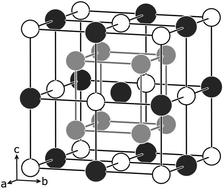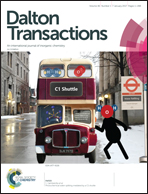A 25Mg, 89Y and 115In solid state MAS NMR study of YT2X and Y(T0.5T′0.5)2X (T/T′ = Pd, Ag, Au; X = Mg, In) Heusler phases
Abstract
Yttrium–transition metal–magnesium (indium) Heusler phases YPd2Mg, YPd2In, YAg2Mg, YAg2In, YAu2Mg, and YAu2In and their quaternary compounds (solid solutions) Y(Pd0.5Ag0.5)2Mg, Y(Pd0.5Ag0.5)2In, Y(Pd0.5Au0.5)2Mg, Y(Pd0.5Au0.5)2In, Y(Ag0.5Au0.5)2Mg and Y(Ag0.5Au0.5)2In were synthesized from the elements in sealed niobium ampoules in a high-frequency furnace or by arc-melting, respectively. All compounds crystallize with the cubic MnCu2Al type structure (Heusler phase), space group Fm![[3 with combining macron]](https://www.rsc.org/images/entities/char_0033_0304.gif) m. The structure of Y(Ag0.39Au0.61)2Mg was refined from single crystal X-ray diffractometer data: a = 689.97(5) pm, wR2 = 0.0619, 52 F2 values, 6 parameters. Magnetic susceptibility measurements show Pauli paramagnetic behavior for all samples. The compounds were investigated by 25Mg, 89Y and 115In solid state MAS NMR spectroscopy. Large positive resonance shifts are observed for all nuclei. A review of the present data in the context of literature data on isotypic Heusler phases with Cd and Sn indicates that the 89Y shifts show a correlation with the electronegativity of the main group atoms (Mg, Cd, In, Sn). The solid solutions Y(Ag1−xTx)2Mg (x = 0.1, 0.25, 0.33, 0.5; T = Pd, Au) clearly show Vegard-like behavior concerning their lattice parameters, and their main group element resonance shifts arising from spin and orbital contributions are close to the interpolated values of the corresponding end-member compounds.
m. The structure of Y(Ag0.39Au0.61)2Mg was refined from single crystal X-ray diffractometer data: a = 689.97(5) pm, wR2 = 0.0619, 52 F2 values, 6 parameters. Magnetic susceptibility measurements show Pauli paramagnetic behavior for all samples. The compounds were investigated by 25Mg, 89Y and 115In solid state MAS NMR spectroscopy. Large positive resonance shifts are observed for all nuclei. A review of the present data in the context of literature data on isotypic Heusler phases with Cd and Sn indicates that the 89Y shifts show a correlation with the electronegativity of the main group atoms (Mg, Cd, In, Sn). The solid solutions Y(Ag1−xTx)2Mg (x = 0.1, 0.25, 0.33, 0.5; T = Pd, Au) clearly show Vegard-like behavior concerning their lattice parameters, and their main group element resonance shifts arising from spin and orbital contributions are close to the interpolated values of the corresponding end-member compounds.


 Please wait while we load your content...
Please wait while we load your content...